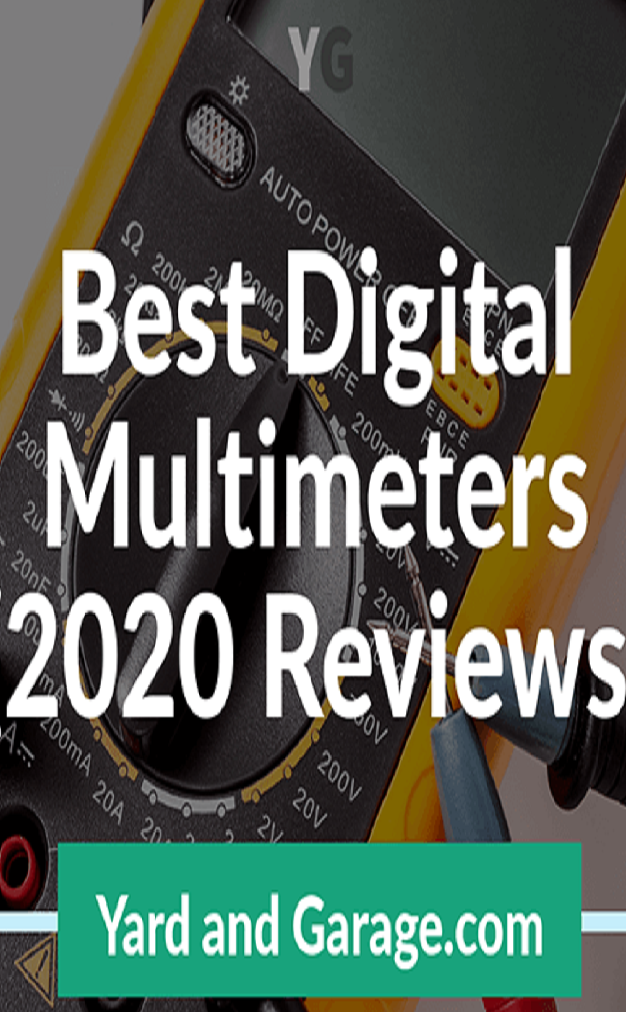
Disclosure: This post contains affiliate links. If you click through and make a purchase, I’ll earn a commission, at no additional cost to you. Read our full disclosure here.
If you are ever going to work around electricity at home, a good multimeter must be in your toolbox. Working around electricity can be dangerous and one of the biggest uses of a multimeter is the detection of current.
Having a solid multimeter will give you the confidence to allow you to work on electrical gizmos in your home. You can troubleshoot electronic gizmos, install ceiling fans, or replace your old fluorescent ballasts with fancy new LED models.
Table of Contents
Quick Look at Our Favorite Multimeters
[amazon table=”3248″]
We have reviewed 9 of the top selling homeowner level multimeters. All listed here are perfect for any electrical-related task you can come up with. The models we have reviewed all range in price from around $10 up to around $130.
The main points we are looking at when reviewing are measurement ranges, special functionality, size, and cost.
The Best Multimeters – Top 9 List
1. Extech EX330 Multimeter – Our Top Pick
[amazon box=”B000EX0AE4″ /]
This is the model I use day to day. I routinely work on small electronics and this model has the sensitivity that I need. The first thing you might notice about the Extech EX330 is the huge display. I’m not old enough to need it, but it is still helpful to see from farther distances.
This model comes with a Non-contact AC detector, although I haven’t had a chance to use it much. If you are nervous checking mains, this is a definite plus. The EX330 has basically all the features I need and is really built well too. It feels sturdy in your hands and while it is bulkier than some of the other models, I like it just fine.
The EX330 gets our top prize for best all-around multimeter.
| Mode | Range | Accuracy |
|---|---|---|
| DC voltage | 400mV – 600V | ±(1.0%+2) @400V |
| AC voltage | 400mV – 600V | ±(1.5%+3) @400mA |
| DC current | 400µA – 10A | ±(1.5%+3) @400mA |
| AC current | 400µA – 10A | ±(1.8%+3) @400mA |
| Resistance | 400Ω – 40MΩ | ±(1.2%+2) @4MΩ |
| Capacitance | 4nF – 200µF | ±(2.5%+4) @400nF |
| Frequency | 5Hz – 10MHz | ±(0.1%+1) |
| Temperature | -4°F to 1382°F | ±(3.0%+8) |
Links: Datasheet | User’s Manual.
Pros
- The best capacitance range of the models.
- Measures both AC/DC current.
- Large display numbers.
- Solid build with rubber cover.
Cons
- Non-contact voltage detector can be hit or miss.
2. AstroAI TRMS 6000 Multimeter – Runner Up
[amazon box=”B071JL6LLL” /]
The AstroAI TRMS 6000 is definitely one to check out if you’re looking for one of the best digital multimeters on the market. It’s equipped with two explosion-proof ceramic fuse tubes to give you double protection. So if safety is one of your biggest concerns, you can be confident that this unit will withstand incidental injury and rough handling.
As this unit is auto-ranging it can perform a wide range of tests such as capacitance and temperature in addition to the usual current, voltage and resistance measurements. It can also test capacitors and transistors with its built-in multi-function socket.
The features described above are not standard and thus are key to what makes this multimeter so special. In addition, the AstroAI TRMS 6000 also comes equipped with a backlit LCD thus making it extremely easy to see even in the darkest of spaces. And to ensure that you don’t lose your measurements while transcribing, it has a useful data hold feature.
And finally, it even has a kickstand and hanging magnet which we considered to be really nice extras. Now, that magnet is actually stronger than you think in that it tends to collect small metal fragments. Regardless, this device is of superb value, but even more so when you consider its modest price point. The AstroAI almost edged out the Extech as our winner, so look at the feature set and see if this one is right for you.
| Mode | Range | Accuracy |
|---|---|---|
| DC voltage | 60mV – 600V | ±0.5% |
| AC voltage | 60mV – 600V | ±1.0% |
| DC current | 600µA – 10A | ±1.8% |
| AC current | 600µA – 10A | ±2.0% |
| Resistance | 600Ω – 60MΩ | ±1.0% |
| Capacitance | 40nF – 4000µF | ±5.0% |
| Frequency | 9.99Hz – 9.99MHz | ±3.0% |
| Temperature | 4°F to 1832°F | ±2.0% |
Links: User’s Manual.
Pros
- True RMS capable.
- Good measurement range.
- Backlit LCD screen.
Cons
- Magnet can be an annoyance, collecting debris.
3. Fluke 115 Multimeter – Premium Model
[amazon box=”B000OCFFMW” /]
Fluke is a name even non-electrians are familier with. This multimeter is one of the best available but it is very pricey. Unless you’re planning on using each day on a professional basis, you may be better off choosing a less-expensive option. That being said, this really is the premiere option. This is a true RMS multimeter which allows you to take very accurate measurements of non-linear loads. The display is offered in either a numerical or graphical display and has an extremely fast response time. This is truly a wonderfully reliable piece of equipment.
For safety, the multimeter is encased with a blast shield; this means that if some catastrophic event occurs, you’re protected from the full force. It also make it extremely durable and robust, able to survive being tossed around a work bench or bag – although given the price you’ll probably want to treat it with a little extra care. However, I have to say that I was taken aback that no case was included given the price. Even though it’s durable, I’d still want to have a case for even more protection.
| Mode | Range | Accuracy |
|---|---|---|
| DC voltage | 600mV – 600V | ±(0.5%+2) |
| AC voltage | 600mV – 600V | ±(1%+3) |
| DC current | 6A – 10A (20A brief overload) | ±(1%+3) |
| AC current | 6A – 10A (20A brief overload) | ±(1.5%+3) |
| Resistance | 600Ω – 40MΩ | ±(0.9%+1) |
| Capacitance | 1000nF – 1000µF | ±(1.9%+2) |
| Frequency | 99.99Hz – 50kHz | ±(0.1%+2) |
| Temperature | N/A | N/A |
Links: Datasheet | User’s Manual.
Pros
- True RMS capable.
- Backlit LCD screen.
- Good capacitance range.
Cons
- Doesn’t measure temperature at this price point.
4. INNOVA 3320 Multimeter – Good Budget Option
[amazon box=”B000EVYGZA” /]
The INNOVA 3320 doesn’t offer all the bells and whistles of some of its competitors. But it will give you accurate results for standard tests at a great price point. But isn’t why we believe it to be such a great value for the money. The super rugged design was a deciding factor in adding this multimeter to our list. You’re probably like me in that your tools just get tossed until they are needed again. If that’s the case, you will really appreciate the rubber guards on this device.
Now, only one set of standard probes is included in this multimeter, but at this price point it’s more than adequate. With a 10MΩ input impedance, the lower cost doesn’t hinder its abilities. Quality control though is definitely an area they could improve in though. Unfortunately, the first device we purchased did not work. However, the second unit we impressed us so we’re willing to give them a pass on the original broken unit.
| Mode | Range | Accuracy |
|---|---|---|
| DC voltage | 200mV – 600V | ±(0.5%+2) |
| AC voltage | 2V – 600V | ±(1%+3) |
| DC current | 20mA – 10A | ±(1%+3) |
| AC current | 20mA – 200mA | ±(1.5%+3) |
| Resistance | 200Ω – 20MΩ | ±(0.9%+1) |
| Capacitance | N/A | N/A |
| Frequency | N/A | N/A |
| Temperature | N/A | N/A |
Links: User’s Manual.
Pros
- Autoranging
- Comes with a battery load test mode.
- Very affordable.
Cons
- Doesn’t measure capacitance.
- AC current has small range.
5. Etekcity MSR-R500 Multimeter – Best Budget Model
[amazon box=”B01N9QW620″ /]
The Etekcity MSR-500 is a palm-sized mini digital multimeter with an attractive display and a rubber sleeve to protect it from drops. It is great for measuring AC/DC voltage and DC current – but not AC current. It also has a handy kickstand for hands-free use as well as a data hold function so that you don’t lose measurements while transcribing them.
If you’re looking for an inexpensive general-use multimeter, the Etekcity MSR-R500 may just fit the bill. While it can be used to test lower level entertainment or home appliance wiring/faults, it is really not made to handle the demands of commercial use.
It also requires the use of manual ranging so would not be the first choice for a novice.
| Mode | Range | Accuracy |
|---|---|---|
| DC voltage | 200mV – 500V | ±(0.5%+2) |
| AC voltage | 0V – 500V | ±(1.2%+10) |
| DC current | 2000μA- 10A | ±(1.2%+2) |
| AC current | N/A | N/A |
| Resistance | 200Ω – 200MΩ | ±(0.8%+2) |
| Capacitance | N/A | N/A |
| Frequency | N/A | N/A |
| Temperature | N/A | N/A |
Links: User’s Manual.
Pros
- It is super affordable.
- Missing some modes.
Cons
- Doesn’t measure capacitance.
- No AC current mode.
6. Amprobe AM-510 Multimeter
[amazon box=”B007FZFTZO” /]
This multimeter has other great abilities in addition to its ability to provide non-contact voltage detection. It has the ability to meet CAT-IV 600V and CAT-III 1000V standards which is extremely impressive. And it is even more considering the price point of this particular device. It also offers a back-lit LCD display with bar graph functionality which is very useful.
And if you find yourself working in extremely dark conditions, this device has a built-in flashlight to help illuminate your work. It also contains a kickstand for those times when you need it to be hands-free.
While we found this multimeter to be quite interesting we can’t justify moving it up on the list. When we tried our unit, several of the settings did not work and we unable to get readings on some of the testing. The Amprobe AM-510 had such great potential so we were really disappointed in how this unit worked in real life. It may be that we just got units from a bad batch or they may have a more serious quality control issue. Again, it was an extremely disappointing development.
| Mode | Range | Accuracy |
|---|---|---|
| DC voltage | 400mV – 600V | ±(0.8%+1) |
| AC voltage | 400mV – 600V | ±(1.0%+3) |
| DC current | 400μA- 10A | ±(1.2%+3) |
| AC current | 400μA- 10A | ±(1.2%+3) |
| Resistance | 400Ω – 40MΩ | ±(1.0%+2) |
| Capacitance | 40nF – 4000μF | ±(3.0%+5) |
| Frequency | 10Hz – 10MHz | ±(0.1%+4) |
| Temperature | -40°F to 1832°F | ±(1.8%+6°F) |
Links: Datasheet | User’s Manual.
Pros
- Good range of measurements.
- CAT-III Safety rating.
Cons
- Complaints of input terminal issues from some customers.
7. Klein Tools MM400 Multimeter
[amazon box=”B018EXZO8M” /]
While Klein may not be the most recognized name in multimeters, the MM400 is a quality choice. The unit itself is a rugged piece of equipment designed by electricians. That’s important because it really does make the unit easy to use. The auto-ranging feature is probably one of its best characteristics – because there are so many of us who don’t understand how to set the range manually. Additionally, this unit is programmed to measure capacitance and temperature in addition to the standard voltage and current.
We love this unit so much that it’s hard to find something negative. About the only thing worth mentioning is a deficiency in true RMS (Root-Mean-Square) accuracy. This may be an issue for professional electricians but it should not be a major inconvenience for the more general user such as The DIYer or hobbyist.
| Mode | Range | Accuracy |
|---|---|---|
| DC voltage | 400mV – 600V | ±(1.2%+3) |
| AC voltage | 4V – 600V | ±(1.5%+5) |
| DC current | 400μA- 10A | ±(1.5%+5) |
| AC current | 400μA- 10A | ±(1.8%+5) |
| Resistance | 400Ω – 40MΩ | ±(2.0%+10) |
| Capacitance | 40nF – 200μF | ±(3.0%+5) |
| Frequency | 10Hz – 50kHz | ±(1.3%+5) |
| Temperature | 0°F to 1000°F | ±(3.0%+9°F) |
Links: Datasheet | User’s Manual.
Pros
- Decent 1 μF capacitance sensitivity.
- Includes a thermocouple for temperature.
- CAT-III Safety rating.
- Sturdy design.
Cons
- Not as accurate as Extech or Fluke models.
- Screen can be hard to read at certain angles.
8. EEVblog BM235 Multimeter
[amazon box=”B01JZ1ADCO” /]
This Brymen BM235 is definitely on the higher end of multimeters and the price reflects it. It is a True RMS (Root-Mean-Square) thereby adjusting for both linear and non-linear waves. It is also rated at CAT-IV up to 300V giving you extra protection.
It also includes a great set of silicone-insulated conductors along with screw-on banana jack ends which is definitely an upgrade from the usual fare.
Honestly we could go on and on about this device including the ergonomic grip, the extra-sharp display and the extremely wide range of volts, amperage, etc. The only hesitation we have with this great multimeter is the price. This is something to put on the Christmas wish list or splurge on when you get that tax refund check in the spring.
| Mode | Range | Accuracy |
|---|---|---|
| DC voltage | 60mV – 1000V | ±(0.3%+2) – ±(0.3%+2) |
| AC voltage | 60mV – 1000V | ±(0.7%+3) – ±(1.0%+3) |
| DC current | 600μA- 10A | ±(0.7%+3) – ±(1.0%+3) |
| AC current | 600μA- 10A | ±(1.5%+3) – ±(1.0%+3) |
| Resistance | 600Ω – 60MΩ | ±(0.3%+3) |
| Capacitance | 20nF – 10mF | ±(1.5%+2) |
| Frequency | 10Hz – 50kHz | ±(0.3%+2) |
| Temperature | -40°F to 752°F | ±(1.0%+2°F) |
Links: User’s Manual.
Pros
- True RMS.
Cons
- Sold out on the manufacturer’s website. Supply may be low.
9. Fluke 101 Multimeter
[amazon box=”B00HE6MIJY” /]
If you’ve dreamed of getting your very own Fluke multimeter but were concerned about price, the Fluke 101 may be a great first investment. This pocket multimeter is only the size of your hand but is professional enough for commercial electricians. It is auto-ranging and CAT-III certified up to 600V.
As this is a smaller version, you don’t have all the capabilities that you would have on a standard Fluke product. The capacitance and frequency ranges are quite narrow but should work fine for HVAC. And while the display is great, there is no back-light. And if you’re looking for a stand, you have to buy that separately. It’s a good quality unit but you may find upgrading to a different unit provides more flexibility.
| Mode | Range | Accuracy |
|---|---|---|
| DC voltage | 6V – 600V | ±(0.5%+3) |
| AC voltage | 600mV – 600V | ±(3.0%+3) – ±(1.0%+3) |
| DC current | N/A | N/A |
| AC current | N/A | N/A |
| Resistance | 400Ω – 40MΩ | ±(0.5%+3) – ±(0.5%+2) – ±(1.5%+3) |
| Capacitance | 50nF – 100µF | ±(2%+5) |
| Frequency | 50Hz – 100kHz | ±(0.1%+3) |
| Temperature | N/A | N/A |
Links: Datasheet | User’s Manual.
Pros
- Tiny, can fit in your shirt pocket.
Cons
- Does not measure current, a deal killer for most people.
- Only 100 μF capacitance.
How to Use a Digital Multimeter
Conclusion
I hope our reviews help you decide on the multimeter that is right for you. As I mentioned earlier, the Extech EX330 is the one I use in the garage and I wholeheartedly recommend it.
With it’s range of sensitivity and helpful features like the stand, I feel it is the best choice, not only for those who like tinkering with electronics, but general household use as well.
Any of the top multimeters we have listed will do well for your home and garage. Depending on your budget and if you want a true RMS meter, you should have a couple of multimeters that will help you on your projects around the house.
If you have any questions about the meters I have reviewed or just multimeters in general, feel free to shoot me a message and I will get back in touch with you. Thanks for reading!



